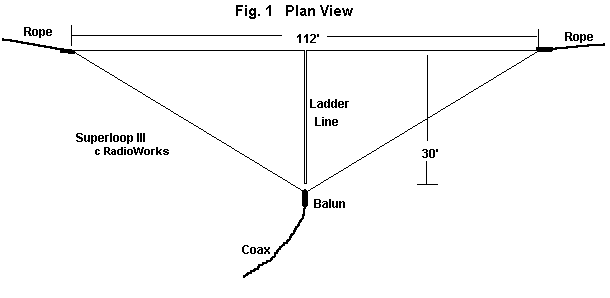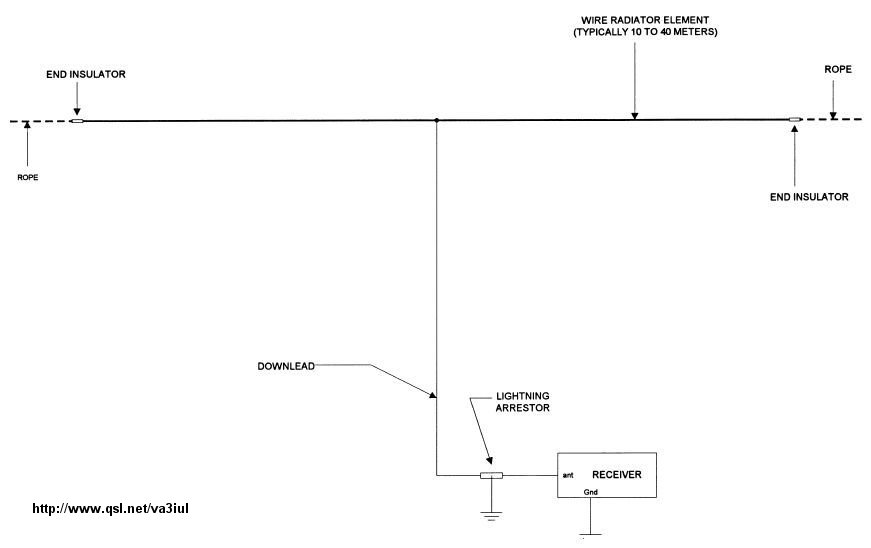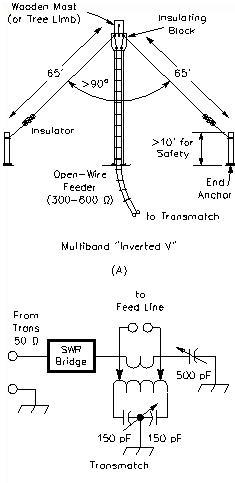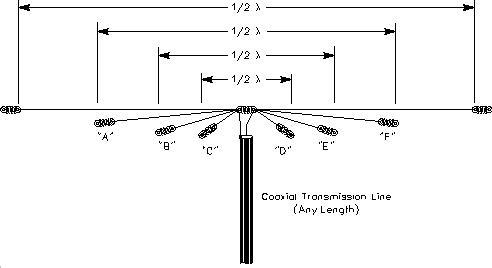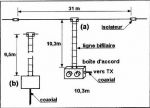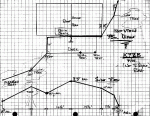(A Reprint by Courtesy of antenneX Online Magazine issue Number: 119 ; http://www.antennex.com)
By Eli Kovo – 4X4LH
Some of us prefer to spend a lot of money on towers, enormous in height and price, with lots of elements antennas and on top of it using the highest legal power. The rest of us, that have to deduct hard earned money from the family budget, have to make some delving in the intricacies of efficient transmitting, propagation problems and its many ingredients, if we want to still enjoy our hobby. It seems that today’s Hi tech brought the hobby to a discouraging state - we don’t build receivers and transmitters any more and on the operating side of it – an endless chasing of dx for a report and a QSL, which doesn’t seem to be the highest goal of our hobby.
What is left to us is indeed, directing our efforts in better understanding the proper use of antennas, evaluating their radiation efficiency, getting to know the fouling behavior of the ionosphere, along with better differentiating between dBi, dBd, dB, etc. and even find out what Radiation resistance is.
After long years of thorough combing the literature, internet and other sources of information, along with building and using many different antennas, I came to the conclusion that one of the best ways to reach efficiently a distant station for a QSO of not less than 10-20 minutes, is the use of vertical antennas with no more than 150-200 watts.
In spite of some “great sages” saying that “a vertical antenna transmits equally bad to all directions”, my present “antenna of the house” is a pile-up busting full wavelength wire Delta Loop, vertically polarized. I realized that the 1/4 wavelength ground plane antenna and the 5/8 wl antenna needing a good "mirror" underneath, are good choice on top of a car’s metal roof, but will put you in jeopardy with your wife’s garden and the lawn mower, if you try to bring them into your home station for HF.
I also realized that although a three or four elements Yagi beam concentrates its power in a narrow horizontal pattern, its vertical “take off ” suffers from a high radiation angle of ~30°, loosing a lot of dB’s in excessive number of hops to the ionosphere, while a good vertical monobander reaches the dx with less hops, with almost the same strength!
I further discovered that following the request of amateurs looking for a single knob (main’s on/off) “no tuning” transceiver, made the manufacturers provide rather compact transceivers but without any way of antenna tuning and loading. Instead - promoting an external ATU to be added to the paraphernalia of the station with, of course, additional expenditure. It happens also because of the wish of amateurs and in many cases their necessity to use one single antenna for as many bands as possible no matter how bad the transmission is. Here lays one of the misunderstandings of many members of our fraternity. When feeding a dipole with its basic frequency it was built for, we get its basic well known clean pattern. Using the same dipole length on other frequencies with an ATU as a mediator, correcting wrong impedance, reactance and SWR for the tx to be happy, BUT:
-
The antenna will not provide the length the wave is looking for, according the rules of Physics.
-
The clean basic pattern of the dipole is distorted into many additional lobes on account of the main lobe.
-
The low take off angle desired for dx is elevated (to warm the clouds), causing more hops on its long way to the dx station.
-
The radiation efficiency becomes so low that out of our 150 watts only 15 poor watts get out on the air.
-
The ionosphere, acting as a mirror, absorbs some of our signal as a “payment for its services”, swallowing 8-10dB (for each hop) of our miserable signal, arriving at the dx station with less then 1 watt.
A correctly transmitting antenna is the best “amplifier” I know. A 3 dB gain doubles the power of your signal and a 6 dB quadruples it. Your 150 watts are sent out as 300 watts! Add the equivalent gain of low take off angle transmission (less hops) and you are better off than a kilowatt!!
I brought this long preface for my hobby fellows, pointing out some of the pitfalls. If we get aware of them we will benefit by better understanding of the how’s and why’s of antennas and enhance our station performance. This will hopefully encourage us to build and use simple, cheap and efficient, low take off angle monoband verticals.
Here comes my modification of the Slim Jim antenna which I call “The 4X4 Slimtenna”. The esteemed Slim Jim antenna was invented by Fred Judd G2BCX on the basis of the J Pole antenna, which was based on the German Zepelin antenna. This one was an endfed dipole, fed by a 1/4 wavelength open wire ladder section, hanging out beneath the big airship. It was actually invented by an Austrian engineer in 1908 intended for use in balloons in a suspended mode. Niels Rudberg OZ8NJ found this astounding fact in an old textbook published quickly in the same year by Dr. J. Zenneck – Professor of Physics in Muenich (RadCom June 2006).

Fig 1. The Zepp and J Pole, the development of the Slim Jim and its upgrade for HF - “The 4X4 Slimtenna”
Both J Pole and the Slim Jim inventors kept its ¼ wavelength matching section in line with the ½ wavelength long antenna, e.g. a half wavelength plus another quarter wavelength. Beneath a balloon or a dirigible this was a fine and suitable arrangement as the antenna and the matching feeder were rolled out at lift off from a drum and rolled back when landing. It is certainly difficult for the ham to cope with these enormous lengths if he wants to use it as a vertical aerial on the HF bands. This is probably the reason why these fine antennas were confined mainly to VHF.
This type of feed can be in line with an endfed antenna or can be bent 90° to it. Both J Pole and Slim Jim can be put up vertically for HF - easier, if the feeding section lays near the ground or the roof. I will refrain discussing the J Pole as it doesn’t offer more than an endfed halfwave dipole.
On the other hand, the Slim Jim is one of the very good antennas offering a good radiation efficiency - having:
-
A driven element that combines the "efforts" of two halfwaves in phase, in a rather restricted space with about 3 dBd gain and an unbelievable 8° take off firing angle towards the horizon - almost parallel to ground!
-
Its overall height is no more than half wavelength.
-
No need at all for (repulsive quantity of) radials to substitute a missing length for our wave to ride on (unlike the ¼ wavelength ground plane searching underneath for its "lost" other 1/4 length, lifting its lobe up to Heaven for help… A pitiful scene).
Although building verticals for HF is easiest for 10 meter band, we will plunge into building it for 20 meters band and find out it isn’t out of the reach of the ham both financially and mechanically. (See Fig. 2)

Fig 2. An overall and detailed view of the components included in the 4X4 Slimtenna

Fig 3. The omega clamps and a flange at 4X4LH’s roof
The height of the whole thing is 10.5 meters. Each leg is made out of 2, 3 or 4 pieces of aluminum pipes fitting in diameter. Starting with a bottom size of ~1.5", the upcoming pieces go into the lower one for at least 10 inches. If the pipes don’t fit snugly, use a piece of aluminum beer can as a shim. I carried a magnet to the grocery shop to find the aluminum ones – the others will rust quickly. The steak I ate was happy with the beer and the pipes were happier with the shims inserted.
At the upper end of each section cut a double slot to clamp the next pipe. Fastening is done by using 2 omega clamps in each place. I don’t rely on hose clamps to hold this weight and mechanical stress (See Fig. 3). Use all the way the same size of stainless steel ¼" (6mm) screws, washers and nuts. It pays back with time! Also, when doing the works you will have to carry one single size of wrenches.
The main fed element rests on a bottle, which is a very good insulator. The other leg is a bit shorter e.g. minus the distance D, and may stay on a proper size and length of Schedule 40 PVC pipe which is also a good insulator. Prepare 6 Plexiglas (or other) spacers. I leave their design purposely to your ingenuity, as long as their size is in accordance with the table of widths below, (Fig. 4) and as long as they keep the two elements parallel. Place them at even distances along the antenna. Remember that the upper pipes get thinner but D stays the same. I don’t go into details not wanting this article to look as if taken out of a cook book (hi).
Try to find in your plumber’s shop 2 strong aluminum or plastic flanges with 3 or 4 holes and insert them at ~1/3 and ~2/3 heights from the bottom for the nylon guy wires. These flanges are supported underneath by the same type of a couple of omega clamps without drilling any holes in the pipes. (see Fig. 3)
The uppermost ends of the two elements are tied together (electrically) by a 1/2" wide aluminum strip, embracing both pipes and fastened tightly with above suggested type of screws. Don’t forget to cap the pipe's ends against rain with anything convenient.

Fig 4. A table for distance D between the two halfwaves in cm and also for other bands
Use some help to lift the whole thing and tie it securely to all tie points you prepared in advance. I personally never tie more than one guywire to the same tie point, just to be on the safe side. If a tie point gets loose and out of its place, holding more than one guywire may cause the fall of the whole structure.
As with every good antenna, this one is also vulnerable to nearby objects like walls, metal structures, trees, etc. They shift the predesigned frequency, usually lowering it and distort the expected pattern, so try to be in the clear.
The right sequence for adjusting the antenna (any antenna) is to resonate it by achieving minimal SWR on the preferred frequency, first by taking care of its length, then with the feeding. Use your SWR meter while your TX is on AM and adjusted for minimum readable power output. By making a graph. like the one below, checking the SWR every 100kHz (See Fig. 5), you will be able to decide whether the antenna is too long or too short. The adjustment is done usually on the shorter leg, where the gap was, but in some cases also on the main leg.

Fig 5. On a math textbook sheet, mark frequency and SWR coordinates
Feeding a high impedance vertical could be done by a coil and a tap for the coax, but such a coil has its own many requirements ( Q, diameter, number of turns, rain cover etc.) and may radiate by itself. This is why an easier, preferred feeder of lossless open wires is used, where current in one wire is out of phase with the current on the other, ensuring no radiation from it. A ¼ wavelength section of 300Ω Twin lead solves nicely our problem. Its far end shorted, twisted and soldered. One conductor of the Twin lead connects to the bottom of the main element by a hose clamp, while the other wire is left not connected. Keep the Twin lead away of ground at the height of the bottle insulator. The necessary impedance of that specially designed for one single band ¼ wavelength matching section, is found out by a very simple formula for matching two (very) different impedances:
Zmatch = √ Zant × Ztx
The bottom end of the Slimtenna presents estimated impedance in the vicinity of ~1500Ω, which I could not actually measure. Adding it to our formula looks like this
= √ 1500 × 50 = √ 75000 = 273.86 Ω
A good quality 300Ω Twin Lead will be near enough for that matching purpose of ours. One more thing to be done is finding the real length of that ¼ wl section. We’ll have to take into account the slowdown speed of our wave, caused by the plastic insulation covering the conductors of the Twin lead. Enter Velocity factor. For Twin lead it is about 0.73, while, for instance, for coax cable it goes down to 0.66. We'll have to multiply the ¼ wl of our matching section by that Velocity factor (0.73) which means actually shortening the way our wave has to travel. To do that we have to decide what our working frequency is – say 14,200 mHz.:
Wavelength in meters = 300 / F MHz
300 / 14.200 = 21.12 meters, but we need only the ¼ of it, so
21.12 / 4 = 5.28 meters, now times “Velocity factor”
5.28 × 0.73 = 3.85 meters of Twin lead
This is the length of the Twin lead to be used to feed our Slimtenna. Not very difficult.
Pierce the insulation of the Twin lead at a distance of ~40 inches from the cold end and connect two alligator clips attached to the feeding coax end. You will probably need to do some more piercing until you find the points of lowest SWR. As it is clear that Twin lead is after all a balanced component, attaching it to an unbalanced coax cable necessitates the use of a 1:1 BalUn, connected to the points you found, with minor moving back and forth for fine tuning. If you happen to have only a 4:1 BalUn, you can use it instead, by looking for the right connection points (~200Ω) further on along the Twin lead, closer to the antenna leg.
Last but not least – from the upper end of the coax cable make a coil of 8 turns (close wound) with a diameter of about 8", without cutting it. You can wrap it on a ~8" plastic coil form (“borrow” a cake form from your wife) or have it air wound. Fasten it in such a way that it looks like a coil and remains like that. This device will prevent the outer side of the coax braid from joining the gang, turning into an antenna by itself, while the inside stream of current is unobstructed. This phenomenon is called “Common mode currents”, meaning - currents flow on the external side of the coax braid during transmission. In common mode language it is simply an RF choke preventing your joyful SSB gurgles from appearing on your “lovely” neighbors TV, Hi Fidelity, computer, wireless phone etc. etc.
Make one last check for the lowest SWR –1.2:1 is very acceptable and you can now solder the BalUn wires to the Twin lead and cover all vulnerable joints with hot glue, RTV etc.
This 4X4 Slimtenna, if adjusted properly and operated correctly as a monoband vertical antenna, will turn out to be your “pileup-buster of the house”– try it!
My best wishes for a good luck with this fine project – 73 de Eli 4X4LH



